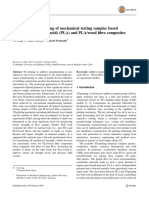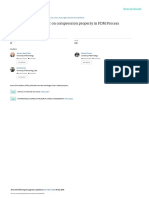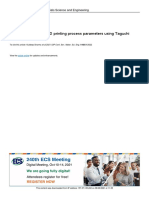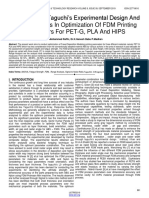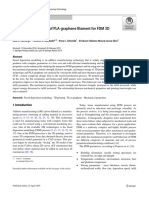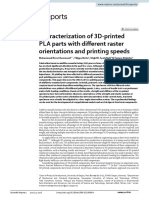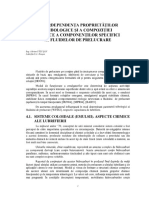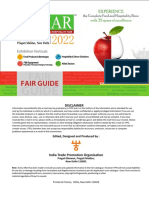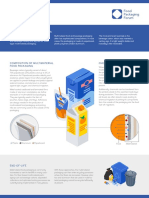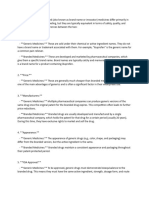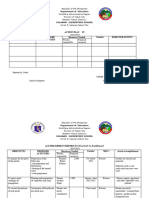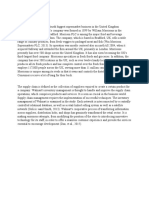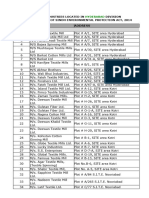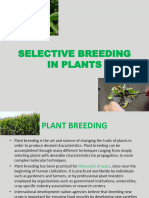Biowood 7
Biowood 7
Uploaded by
Irina BesliuCopyright:
Available Formats
Biowood 7
Biowood 7
Uploaded by
Irina BesliuOriginal Title
Copyright
Available Formats
Share this document
Did you find this document useful?
Is this content inappropriate?
Copyright:
Available Formats
Biowood 7
Biowood 7
Uploaded by
Irina BesliuCopyright:
Available Formats
ISSN: 2277-9655
[Valles-Rosales* et al., 7(5): May, 2018] Impact Factor: 5.164
IC™ Value: 3.00 CODEN: IJESS7
IJESRT
INTERNATIONAL JOURNAL OF ENGINEERING SCIENCES & RESEARCH
TECHNOLOGY
EFFECT ANALYSIS OF FUSE DEPOSITION MODELING PROCESSES ON
MECHANICAL PROPERTIES OF WOOD PLASTIC COMPOSITES
Elias H. Arias-Nava 1, Delia J. Valles-Rosales*2, Juan Miguel Diaz-Mendoza3, Luis Alberto
Rodriguez-Picon4, Luis Carlos Mendez-Gonzalez5
*1,2,3
Department of Industrial Engineering, New Mexico State University, USA.
4,5
Department of Industrial Engineering and Manufacturing, Autonomous University of Ciudad
Juarez, Mexico.
DOI: 10.5281/zenodo.1247027
ABSTRACT
Nowadays, fuse deposition modeling is a growing fabrication technology for developing new products. When
using plastics, these processes present various challenges related to fusion distribution, fuse deposition paths, part
orientation, and layer thickness among others. The problem is increased however, when fabricating parts using
materials that are limited in the literature. The use of different equipment may produce variations in the mechanical
properties of a product. This study analyzes the effects of process parameters as well as the use of two different
fuse deposition models on mechanical properties of wood-plastic composites. A design of experiments is proposed
as a methodology to evaluate the objectives of the study. Results show that makerbot™ is a promising option to
improve ultimate tensile strength exposed to different conditions of fabrication. It was observed that the
makerbot™ and the printrbot™ had a significant difference in the tensile strength in the wood-plastic composite
filled samples. The layer thickness of the samples has a significant impact in the mechanical properties, the tensile
strength decreases as the thickness increases
KEYWORDS: 3D printing · additive manufacturing · fuse deposition modeling · mechanical properties · wood
plastic composites
I. INTRODUCTION
Wood plastic composites (WPC) are materials that in general are based on a composition of polymers, fiber plant,
and coupling agent. The polymer is the matrix of the WPC. The most common polymers used in these kinds of
applications are polyethylene (PE), Acrylonitrile Butadiene Styrene (ABS), polypropylene (PP), and poly-lactic
acid (PLA) among others. The fiber is the base or reinforcement of the polymer composite. This can be wood,
stem rice, juke, nut shell, bamboo, flax and others Ashori [2]. A coupling agent (CA) is a chemical additive used
as a bonding mechanism of the fiber and polymer. Variations of the percentage of this CA component is normally
used for improving mechanical properties. WPCs have been used in different applications such as in fencing,
decking, flooring, construction, and automotive parts among others. In addition, they have excellent physical and
mechanical properties; they are as well of low cost, renewable, and easy of manufacturing.
Injection Molding and extrusion processes have been traditionally employed in the process of WPCs products.
Currently, additive manufacturing has been explored to be used in the fabrication of parts using WCPs. This
represents unique challenges in features such as fuse deposition paths, part orientation, and layer thickness.
Manufacturers of FDM machines are currently working on addressing these challenges in various ways which
lead to different results impacting most materials specifically their mechanical properties. The precision of each
type of machine is definitely a consideration in the selection of a 3-D printing system. Wang et al [9] Bellini and
Güçeri, [3]. Few studies have analyzed the use of FDM machines with the purpose of improving mechanical
properties in WPCs . Le Duigou et al [5] analyzed the mechanical properties of wood plastic composites using
PLA and poly (hydroxyalkanoate) (PHA) combined with wood flour material. The study describes the effects of
printing parameters in fuse deposition modeling process (Prusa i3 Rework 3D printer) in the hygroscopic and
mechanical properties. The methodology used to manufacture WPC samples consisted of the use of a commercial
filament (ColorFab) with a blend of PLA and PHA combined with 10-20% recycled wood fiber content. The
process parameters were filling orientation set at 0 and 90 degrees along the X axis and layer thickness set at 100
and 300%. Nozzle temperature, heating plate temperature, and printing speed were parameters identified as having
http: // www.ijesrt.com © International Journal of Engineering Sciences & Research Technology
[318]
ISSN: 2277-9655
[Valles-Rosales* et al., 7(5): May, 2018] Impact Factor: 5.164
IC™ Value: 3.00 CODEN: IJESS7
no significant effect in the properties of WPC. Tensile stress, porosity, and swelling rate were the response
parameters. Results indicated that layer thickness and orientation have a significant effect in the tensile stress.
More specifically, 0 degrees’ orientation had a higher tensile stress than the 90 degrees’ orientation. A small layer
thickness observed a higher tensile stress.
Saidin et al [7] worked in the process of developing a wood based composite material for 3D printing using a mix
of wood flour and ZP102 commercial material. This material is used for building furniture prototypes, art, or
architecture mock up. The composition of the new material consisted of three mesh ranges of wood powder: 90m,
120m and 150m sizes and three mix ratios of wood flour 25%, 50% and 75%. A 3D printer from Z corporation
Z406, was used to manufacture tensile specimens according to the ASTM D1037 standard and tested in a UTM
tensile machine. The results showed that tensile stress increased with the increased of wood content. However,
tensile stress decreased as volume percentage increased over 50%. It was also observed that hardness increased
as wood content increased. In the aforementioned WPC articles, one discussed the effect of setting parameters in
one machine in the mechanical properties of WPC; the other focused on developing a WPC and no changes on
printing parameters. However, neither of the studies analyzed the effects of different printers in the mechanical
properties. Despite of the progress of the aforementioned studies, there is limited information in determining
process repeatability in achieving same properties in different machines. Several work has been done using plastic
filaments Bellini and Güçeri [ 3], Griffiths et al [4], Ahn et al [1], Quintana et al [6], Torrado et al [8], however,
there is not enough information in determining process repeatability when manufacturing WPCs and their impact
on achieving same mechanical properties. Therefore, this paper presents a study of the effects of the use of two
different FDM machines in the manufacturing WPC specimens. The content of the article is organized as follows:
section 2 shows a description of the proposed methodology and experimentation, section 3 shows the analysis and
results, and section 4 presents the concluding remarks and insights for future research.
II. MATERIALS AND METHODS
Methodology
The methodology to test for repeatability consists of setting up two FDMs and a design of experiments using three
parameters to control described as temperature, layer thickness, and the type of machine. Next step in the
methodology is described as the manufacturing of wood plastic composite specimens using the ASTM D638-14
Type V standard. The response variable was the ultimate tensile strength (UTS) given in mega-pascal (Mpa) units.
Finally, the specimens were tested following the tensile test requirements using a universal testing machine with
a constant speed rate of crosshead-movement type.
Material and Equipment
Wood plastic composite material was used to manufacture a total of 40 specimens. This material is a commercial
MG Chemicals ® WPC with a filament diameter of 1.75mm consisting of a ratio of 70% of poly lactic acid and
30% of pinewood. The 3D printing machines used were a MakerBot Replicator 2X Experimental 3D Printer ™
and a printrbot simple™. Both 3D printer machines (shown in Figure 1) have same characteristics in terms of
print resolution, print speed, extruder, and filament size. Controllable parameters were printing temperature, and
layer height. In addition, variables such as printing angle, orientation, printing pattern, material type, field density,
printing speed, and filament diameter were kept constant during the experimentation.
Figure 1. Printrbot (left) Makerbot (right)
Experimental Design
Wood The experimental design included three variables, two quantitative (temperature and layer height) and one
qualitative variable (3D printing machine). The experiment was a 23 full factorial design with a total of eight runs
and five replications. A total of 40 samples were fabricated using the 3D printers and then tested for ultimate
tensile strength (Mpa) using a universal testing machine (shown in Figure 2).
http: // www.ijesrt.com © International Journal of Engineering Sciences & Research Technology
[319]
ISSN: 2277-9655
[Valles-Rosales* et al., 7(5): May, 2018] Impact Factor: 5.164
IC™ Value: 3.00 CODEN: IJESS7
Figure 2. Universal testing machine used to measure the ultimate tensile strength
Additionally, table 1 presents the experimental plan and data related to the tensile testing, five replications and 8
runs for a total of 40 samples, re results are presented.
Table 1. Design of experiment and tensile test results (Mpa)
Variables Replication
Run (A) (B) (C) 1 2 3 4 5
1 205 0.1 m 44.53 55.46 42.85 36.44 42.37
2 215 0.1 m 41.74 51 43.56 44.19 37.34
3 205 0.2 m 39.65 37.03 35.48 39.19 39.67
4 215 0.2 m 41.7 40.11 39.65 34.93 39.24
5 205 0.1 p 31.08 33.57 35.46 36.34 29.84
6 215 0.1 p 47.31 33.85 35.47 35.13 32.47
7 205 0.2 p 31.67 37.56 36.07 33.04 32.8
8 215 0.2 p 35.92 32.7 26.39 35.99 31.58
III. RESULTS AND DISCUSSION
Analysis and Results
Summarizing, 40 poly lactic acid and pinewood composites specimens were fabricated with FDM technology.
The samples were printed in two different 3D printers to investigate the influence of the equipment used to
fabricate the specimens in the mechanical properties of the material. The set-up conditions of the 3D, specifically
the temperature of the printing process and the height (thickness) of each layer on the specimens were analyzed.
The analysis of variance (ANOVA) provided information related to the importance and significance of each one
of the three factors: Temperature (A), Layer height (B) and Printer (C). The resulted model is statistically
significant with a p-value of 0.0004 (shown in table 2).
Table 2. Analysis of variance for the DOE results
Source Sum of df Mean F-Value p-value
Squares Square
Model 700.07 7 100.01 5.43 0.0004
A-A 2.58 1 2.58 0.14 0.7104
B-B 121.20 1 121.20 6.58 0.0152
C-C 503.31 1 503.31 27.32 <0.0001
AB 8.16 1 8.16 0.44 0.5103
AC 1.84 1 1.84 0.10 0.7537
BC 32.45 1 32.45 1.76 0.1938
ABC 30.50 1 30.50 1.65 0.2074
Pure Error 589.36 32 18.41
Cor Total 1289.44 39
http: // www.ijesrt.com © International Journal of Engineering Sciences & Research Technology
[320]
ISSN: 2277-9655
[Valles-Rosales* et al., 7(5): May, 2018] Impact Factor: 5.164
IC™ Value: 3.00 CODEN: IJESS7
Individually each factor was analyzed concluding that layer height and the printer type were statistically
significant with p-values of 0.0152 and 0.0001 respectively. Temperature was not a significant factor meaning
that the specimens can be manufactured at their lowest temperature value. The graphical representation of the
influence of the factors is presented in figure 3. It can be observed that factors B and C affects significantly the
response in (UTS) while factor A does not have a statistically significant effect in the response. In addition, the
results of the analysis suggested that there is a slight interaction between factors B and C, however, it is not strong
enough to be considered statistically significant.
Figure 3. Main effects of individual factors (Temperature (A), layer (B) and 3D printer (C).
A normality test was performed as part of the proposed methodology. Figure 4 shows that the values were
normally distributed, even though the normality test results were close to the rejection region (p-value = 0.112).
Figure 4. Normality test for residuals
A plot of the residual versus run is presented in the figure 5 to demonstrate the independence of the residual (εi),
this test in necessary to avoid biased estimates that may lead to invalid inference in the statistical analysis and in
the regression model presented in this paper.
Figure 5. Residuals vs Run
Finally, the resulted R-squared in the experiment was slightly low with a value of 0.540. Potential interpretation
http: // www.ijesrt.com © International Journal of Engineering Sciences & Research Technology
[321]
ISSN: 2277-9655
[Valles-Rosales* et al., 7(5): May, 2018] Impact Factor: 5.164
IC™ Value: 3.00 CODEN: IJESS7
is that the commercial WPC filament used in the experimentation does not provide enough technical information
about the extrusion process used in the fabrication of the filament as well as other components of the composite
employed such as coupling agents and fire retardants. Having this information available will enhance the results
of this study.
Optimization: FDM
The results regarding the tensile strength showed significant results between the two 3D printers. Ultimate tensile
strength (UTS) was significantly higher on samples fabricated with the makerbot™ printer. The results showed a
20.33 percent higher ultimate tensile strength. The point prediction indicates the highest value that in this case
each printer can achieve. In this experiment, the makerbot™ maximum point reached 44.33 Mpa, on the other
hand the printrbot™ reached 36.84 Mpa as the maximum tensile point. In addition, when using the makerbot™
during the optimization of factors affecting UTS, the results presented in figure 6 show a smoother graph transition
rate when changes in temperature.
Figure 6. Point prediction: Makerbot™
On the other hand, figure 7 shows a large variation on the graph transition rate of the printrbot™ when changes
in temperature are presented.
Figure 6. Point prediction: printrbot™
In conclusion, the study shows that the use of the makerbot™ maximizes the tensile stress compared to the
printrbot™. In addition, the model that provides the best results when using the maketbot™is the one that uses a
combination of factors temperature set up at 205 degrees and layer height set up at 0.10 mm. In this study no
statistically significant interaction of factors was found when using maketbot™ nor printrbot™
For maketbot™
Yi= 35.85 + 0.0508A – 34.815B (1)
For printrbot ™
Yi= 28.755 + 0.0508A – 34.815B (2)
IV. CONCLUSION
The overall goal of this research was the technical comparison of the FDM machines makerbot™ and printrbot™
http: // www.ijesrt.com © International Journal of Engineering Sciences & Research Technology
[322]
ISSN: 2277-9655
[Valles-Rosales* et al., 7(5): May, 2018] Impact Factor: 5.164
IC™ Value: 3.00 CODEN: IJESS7
through the use of design of experiment to arrange the sample fabrication and ANOVA to evaluate the results.
ASTM standards were considered to validate the experimentation as well as five replications per run. The
specimens’ appearance was compared with other filaments from previous studies suggested that the internal
adhesion between PLA and pine wood was good. Ultimate tensile strength was selected as indicator of the
response to analyze the behavior of the specimens under different conditions of fabrication. It was observed that
the makerbot™ and the printrbot™ had a significant difference in the tensile strength in the WPC filled samples.
The layer thickness of the samples has a significant impact in the mechanical properties, the tensile strength
decreases as the thickness increases. Moreover, there is a significant correlation between each of the parameters
analyzed (temperature and layer thickness) and the effect on the mechanical properties. Future research would
involve the use of composites where information on the composition will be available. In addition, layer pattern
and layer printing orientation will be observed as well as a variation of proportions wood, plastic, and coupling
agents among other components.
V. ACKNOWLEDGEMENTS
We would like to thank the USDA I-DISCOVER Grant Funded by the US Department of Agriculture for
their support. Award # 2014-38422-22078.
We would like to thank the National Institute of Food and Agriculture, U.S. Department of Agriculture, under the
"Wheels of Change Grant" Award number 2015-38422-24112 for their support.
VI. REFERENCES
[1] S-H. Ahn, M. Montero, D. Odell, S. Raundy, and P. Wright Paul, “Anisotropic material properties of
fused deposition modeling ABS,” Rapid Prototyping Journal (Emerald Insight) 8, no.4 (2002): 248-257.
[2] A. Ashori, "Wood Plastic composites as promising green-composites for automotive industries,"
Bioresource technology (Elsevier) 9, no. 4 (2008): 4661-4667.
[3] A. Bellini and S. Guçeri, "Mechanical characterization of parts fabricated using fused deposition
modeling," Rapid Prototyping Journal (Emerald) 9, no.4 (2003): 252-264.
[4] C. A. Griffiths, J. Howarth, G. De-Almeida Rowbotham, and A. Rees, "Effect of build parameters on
processing efficiency and material performance in fused deposition modelling," Procedia The Second
CIRP Conference on Biomanufacturing (Elsevier) 49, (2016): 28-32.
[5] A. Le Duigou, M. Castro, R. Bevan, N. Martin, "3D printing of wood fibre biocomposites: From
mechanical to actuation functionality," Materials and Design (Elsevier) 96 (2016): 106-114.
[6] R. Quintana, J. W. Choi, K. Puebla, and R. Wicker, "Effects of build orientation on tensile strength for
stereolithography-manufactured ASTM D-638 type I specimens," The International Journal Advanced
Manufacturing Technology (Springer-Verlag) 46, no.46 (2010): 201-215.
[7] [7] W. Saidin, A. Wagiman, M. Ibrahim, “Development of wood-based composites material for 3D
printing process,” Applied Mechanics and Materials (Trans Tech Publ) 315 (2013): 987-991.
[8] [8] A. R. Torrado, C. M. Shemelya, J. D. Englisha, Y. Lin, R. B. Wicker, and D. A. Roberson,
"Characterizing the effect of additives to ABS on the mechanical propertyanisotropy of specimens
fabricated by material extrusion 3D printing," Additive Manufacturing (Elsevier) 6 (2015): 16-29.
[9] X. Wang, M. Jiang, Z. Zhou, J. Gou, and D. Hui, "3D printing of polymer matrix composites: A review
and prospective." Composites Part B: Engineering (Elsevier) 110 (2017): 442-458.
CITE AN ARTICLE
Arias-Nava, E., Valles-Rosales, D., Diaz-Mendoza, J., Rodriguez-Picon, L., & Mendez-Gonzalez, L.
(2018). EFFECT ANALYSIS OF FUSE DEPOSITION MODELING PROCESSES ON
MECHANICAL PROPERTIES OF WOOD PLASTIC COMPOSITES. INTERNATIONAL JOURNAL
OF ENGINEERING SCIENCES & RESEARCH TECHNOLOGY,7(5), 318-323.
http: // www.ijesrt.com © International Journal of Engineering Sciences & Research Technology
[323]
You might also like
- Effect of Infill Pattern and Ratio On The Flexural and Vibration Damping Characteristics of FDM Printed PLA SpecimensDocument8 pagesEffect of Infill Pattern and Ratio On The Flexural and Vibration Damping Characteristics of FDM Printed PLA SpecimensGiank MarchNo ratings yet
- 16.additive Manufacturing of Mechanical Testing Samples Based On Virgin Poly (Lactic Acid) (PLA) and PLA-wood Fibre CompositesDocument12 pages16.additive Manufacturing of Mechanical Testing Samples Based On Virgin Poly (Lactic Acid) (PLA) and PLA-wood Fibre CompositesAnand NagarajanNo ratings yet
- 1 s2.0 S2214785322037427 MainDocument6 pages1 s2.0 S2214785322037427 MainTayyab AliNo ratings yet
- IRJMETS60400200787 AprilDocument7 pagesIRJMETS60400200787 AprilGopinath GangadhariNo ratings yet
- 4079 ArticleText 6905 2 10 20201220Document9 pages4079 ArticleText 6905 2 10 20201220arth202No ratings yet
- Machine_Learning_Study_of_the_Effect_of_Process_PaDocument23 pagesMachine_Learning_Study_of_the_Effect_of_Process_PahabibiNo ratings yet
- Additive Manufacturing of PLA Structures Using Fused DepositionDocument15 pagesAdditive Manufacturing of PLA Structures Using Fused DepositionMechanical ClassNo ratings yet
- Materials Today: Proceedings: Vishal Wankhede, Darshit Jagetiya, Akshata Joshi, Rakesh ChaudhariDocument4 pagesMaterials Today: Proceedings: Vishal Wankhede, Darshit Jagetiya, Akshata Joshi, Rakesh Chaudharisubhashraj18No ratings yet
- Impact of Process Parameters On Improving The Performance of 3D Printed Recycled Polylactic Acid (rPLA) ComponentsDocument29 pagesImpact of Process Parameters On Improving The Performance of 3D Printed Recycled Polylactic Acid (rPLA) ComponentsSehili Mohamed houssemNo ratings yet
- Mazlan Et Al, 2023 JMechEDocument17 pagesMazlan Et Al, 2023 JMechETS DR ABDUL HALIM ABDULLAHNo ratings yet
- Ijet17 09 02 0442Document13 pagesIjet17 09 02 0442akaslanselman19No ratings yet
- 10 46519-Ij3dptdi 1088805-2313733Document12 pages10 46519-Ij3dptdi 1088805-2313733abdellahabdelmoula.01No ratings yet
- Effect of Infill Parameter On Compression Property in FDM ProcessDocument5 pagesEffect of Infill Parameter On Compression Property in FDM Processweelun yapNo ratings yet
- Analysis of Printing Variables To Enhance PLA, ABS, PETG 3D PrintedDocument16 pagesAnalysis of Printing Variables To Enhance PLA, ABS, PETG 3D Printedalidina538No ratings yet
- 3-D Printer Settings Effects On The Thermal Conductivity of AcrylonitrileDocument7 pages3-D Printer Settings Effects On The Thermal Conductivity of AcrylonitrileUdesh MadurangaNo ratings yet
- Effect of Infill Parameter On Compression Property in FDM ProcessDocument5 pagesEffect of Infill Parameter On Compression Property in FDM ProcessAadelNo ratings yet
- 2021+FDM+IOP Conference PaperDocument12 pages2021+FDM+IOP Conference Paperkuldeep sharmaNo ratings yet
- Biowood 10Document8 pagesBiowood 10Irina BesliuNo ratings yet
- Biowood 0Document21 pagesBiowood 0Irina BesliuNo ratings yet
- Optimization of FDM Process Parameters To Minimize Surface Roughness With Integrated Artificial Neural Network Model and Symbiotic Organism SearchDocument17 pagesOptimization of FDM Process Parameters To Minimize Surface Roughness With Integrated Artificial Neural Network Model and Symbiotic Organism SearchJyotisMan BorahNo ratings yet
- Polymers 15 03419 With CoverDocument23 pagesPolymers 15 03419 With Coversemevi5915No ratings yet
- 10 26701-Ems 1395362-3556892Document8 pages10 26701-Ems 1395362-3556892perspektifgokhanNo ratings yet
- Chapter 2Document6 pagesChapter 2SHYAM SUNDARNo ratings yet
- Tuncel Ticmet 2023Document12 pagesTuncel Ticmet 2023SHYAM SUNDARNo ratings yet
- A Review On Process Parameter Optimization in Material Extrusion Additive Manufacturing Using ThermoplasticDocument4 pagesA Review On Process Parameter Optimization in Material Extrusion Additive Manufacturing Using ThermoplasticInternational Journal of Innovative Science and Research TechnologyNo ratings yet
- The Influence of Process Parameters On The Surface Roughness of The 3d Printed Part in FDM ProcessDocument9 pagesThe Influence of Process Parameters On The Surface Roughness of The 3d Printed Part in FDM ProcessJohnNo ratings yet
- Effect of Fused Deposition ModellingDocument10 pagesEffect of Fused Deposition ModellingMechanical ClassNo ratings yet
- Preprints202306.0945.v1 2Document21 pagesPreprints202306.0945.v1 2alidina538No ratings yet
- Rankouhi Et. Al., 2016Document15 pagesRankouhi Et. Al., 2016siyu chenNo ratings yet
- 2 Tanikella2017Document20 pages2 Tanikella2017Achyut TrivediNo ratings yet
- Materials Today: Proceedings: Muammel M. Hanon, László Zsidai, Quanjin MaDocument8 pagesMaterials Today: Proceedings: Muammel M. Hanon, László Zsidai, Quanjin MaLuqman Hakim ZaimuriNo ratings yet
- EMA and Characterization of AM PolymersDocument19 pagesEMA and Characterization of AM PolymersGiank MarchNo ratings yet
- An_overview_of_additive_manufacturing_methods_mateDocument42 pagesAn_overview_of_additive_manufacturing_methods_matelonerdropNo ratings yet
- Ijamev4n6spl 01Document6 pagesIjamev4n6spl 01ahmed titoNo ratings yet
- Application of Taguchis Experimental Design and Range Analysis in Optimization of FDM Printing Parameters For Pet G Pla and HipsDocument12 pagesApplication of Taguchis Experimental Design and Range Analysis in Optimization of FDM Printing Parameters For Pet G Pla and HipsMohammedrafficNo ratings yet
- Materials 16 04574 v2Document19 pagesMaterials 16 04574 v2mosojo111No ratings yet
- Effect of Infill Density and Pattern On The Specific Load CapacityDocument11 pagesEffect of Infill Density and Pattern On The Specific Load CapacityYash MundlothNo ratings yet
- Effect of Infill Pattern Scaling On Mechanical Properties of FDM Printed PLA SpecimensDocument9 pagesEffect of Infill Pattern Scaling On Mechanical Properties of FDM Printed PLA Specimensctong6255No ratings yet
- Sreenidhi Institute of Science and TechnologyDocument15 pagesSreenidhi Institute of Science and TechnologyPrashanth GurramNo ratings yet
- Influence of Layer Thickness and Infill Density On The Impact Strength of Carbon Particle and PolDocument13 pagesInfluence of Layer Thickness and Infill Density On The Impact Strength of Carbon Particle and PolAndre AbdullahNo ratings yet
- 1 s2.0 S0263822318312005 MainDocument12 pages1 s2.0 S0263822318312005 MainCillian ThompsonNo ratings yet
- Optimization of Injection Molding Process For Kenaf and Polypropylene Composite To Improve Its Tensile StrengthDocument9 pagesOptimization of Injection Molding Process For Kenaf and Polypropylene Composite To Improve Its Tensile StrengthIJRASETPublicationsNo ratings yet
- 5.mechanical Properties of PLA-graphene Filament For FDM 3D PDFDocument21 pages5.mechanical Properties of PLA-graphene Filament For FDM 3D PDFAnand NagarajanNo ratings yet
- Srinivasan 2020Document8 pagesSrinivasan 2020Jasper JazNo ratings yet
- Design and Development of A Low-Cost Open-Source 3D Printer and ItsDocument11 pagesDesign and Development of A Low-Cost Open-Source 3D Printer and ItsGlessy SilvestreNo ratings yet
- Anisotropic Finitie Element Modeling of The Fused Deposition Modeling Process - SkylerOgden - ScottKesslerDocument9 pagesAnisotropic Finitie Element Modeling of The Fused Deposition Modeling Process - SkylerOgden - ScottKesslerSkylerNo ratings yet
- 3 Dprinting 1Document9 pages3 Dprinting 1namasse.medamineNo ratings yet
- Materials and Design: Yu Zhao, Yuansong Chen, Yongjun ZhouDocument10 pagesMaterials and Design: Yu Zhao, Yuansong Chen, Yongjun ZhouFellipe LavaquiNo ratings yet
- Report OE6 FA2 New EdittDocument13 pagesReport OE6 FA2 New Edittoom29101804No ratings yet
- Paper COBEM 2021 - Valente Buenos Daudt Pizzolato V2Document9 pagesPaper COBEM 2021 - Valente Buenos Daudt Pizzolato V2jão silvestre da cunhaNo ratings yet
- Article 6Document5 pagesArticle 6Irina BesliuNo ratings yet
- Experimental_testing_of_PLA_biodegradable_thermoplDocument7 pagesExperimental_testing_of_PLA_biodegradable_thermopllonerdropNo ratings yet
- Domínguez-Rodríguez2018 Article AnAssessmentOfTheEffectOfPrintDocument11 pagesDomínguez-Rodríguez2018 Article AnAssessmentOfTheEffectOfPrintdavid friasNo ratings yet
- Investigation On Influence of Infill Pattern and Layer Thickness On Mechanical Strength of PLA Material in 3D Printing TechnologyDocument11 pagesInvestigation On Influence of Infill Pattern and Layer Thickness On Mechanical Strength of PLA Material in 3D Printing TechnologyfreeroamNo ratings yet
- Claudio 2022Document15 pagesClaudio 2022Ali MNo ratings yet
- ArdionDocument4 pagesArdionReinaldi Luthfi AmirNo ratings yet
- Fatigue Performance of Fused Filament Fabrication PLA SpecimensDocument8 pagesFatigue Performance of Fused Filament Fabrication PLA SpecimensMechanical ClassNo ratings yet
- International Journal of Chemical Engineering - 2022 - Raja - Optimization of 3D Printing Process PDocument7 pagesInternational Journal of Chemical Engineering - 2022 - Raja - Optimization of 3D Printing Process PAnto KumarNo ratings yet
- Effects of Layer Thickness and Binder Saturation LevelDocument10 pagesEffects of Layer Thickness and Binder Saturation LevelDaniel SolesNo ratings yet
- Stas 3dprintingDocument25 pagesStas 3dprintingIrina BesliuNo ratings yet
- Interesant TempDocument12 pagesInteresant TempIrina BesliuNo ratings yet
- Biowood 16Document11 pagesBiowood 16Irina BesliuNo ratings yet
- OTS Optical Tool Setter: Installation GuideDocument52 pagesOTS Optical Tool Setter: Installation GuideIrina BesliuNo ratings yet
- Biowood 18Document19 pagesBiowood 18Irina BesliuNo ratings yet
- Biowood 3Document10 pagesBiowood 3Irina BesliuNo ratings yet
- Calcul AdaosuriDocument306 pagesCalcul AdaosuriIrina BesliuNo ratings yet
- Oferta CateringDocument9 pagesOferta CateringIrina BesliuNo ratings yet
- Measurement Report: 30.00 ( M) Nanofocus AGDocument1 pageMeasurement Report: 30.00 ( M) Nanofocus AGIrina BesliuNo ratings yet
- Singh Review On Recent Adv in MFG SC A Technol V 39 NR 1 2015Document22 pagesSingh Review On Recent Adv in MFG SC A Technol V 39 NR 1 2015Irina BesliuNo ratings yet
- All 5Document8 pagesAll 5Irina BesliuNo ratings yet
- Neha 2020 TendinteDocument16 pagesNeha 2020 TendinteIrina BesliuNo ratings yet
- Matecconf Imanee2018Document6 pagesMatecconf Imanee2018Irina BesliuNo ratings yet
- Oct. 5, 1965 K. Burgsmueller 3,209,652: Filled March 30, 96Document6 pagesOct. 5, 1965 K. Burgsmueller 3,209,652: Filled March 30, 96Irina BesliuNo ratings yet
- Ai Fluidelor de Prelucrare: 4.1. Sisteme Coloidale (Emulsii) - Aspecte Chimice Ale LubrifieriiDocument14 pagesAi Fluidelor de Prelucrare: 4.1. Sisteme Coloidale (Emulsii) - Aspecte Chimice Ale LubrifieriiIrina BesliuNo ratings yet
- TV 18 2011 3 363 368Document6 pagesTV 18 2011 3 363 368Irina BesliuNo ratings yet
- Eti̇yopya Ki̇myasal Madde İthalatçilariDocument94 pagesEti̇yopya Ki̇myasal Madde İthalatçilariDış Ticaret PlatformuNo ratings yet
- Penawaran Harga BMHP Apotek (Oktober 2022) - PPN 11Document7 pagesPenawaran Harga BMHP Apotek (Oktober 2022) - PPN 11Muhammad Rafi'i Sya'bani100% (1)
- 2. 產品簡介20231107Document45 pages2. 產品簡介20231107ermsamchangNo ratings yet
- Amazons Supply ChainDocument2 pagesAmazons Supply ChainHoài Nguyễn Thị ThuNo ratings yet
- Development of PBAT Based Bio Filler Masterbatch: A Scientific Research Proposal OnDocument15 pagesDevelopment of PBAT Based Bio Filler Masterbatch: A Scientific Research Proposal OnManmathNo ratings yet
- MEC50U01Document1 pageMEC50U01Максим БезчаснийNo ratings yet
- Food and Drug Administration Center For Drug Regulation and R Food and Drug Administration Center For Drug Regulation and Research EsearchDocument141 pagesFood and Drug Administration Center For Drug Regulation and R Food and Drug Administration Center For Drug Regulation and Research EsearchJha JhaNo ratings yet
- Book AAHAR2842022Document463 pagesBook AAHAR2842022Kunal Singhal100% (1)
- Exploring The Challenge and Scope of Solid Waste Management: A Comparative Analysis of Bangladesh and TurkeyDocument9 pagesExploring The Challenge and Scope of Solid Waste Management: A Comparative Analysis of Bangladesh and TurkeyMarivic Baguinaon CarpioNo ratings yet
- W5 Familys Animal RP Mod11Document10 pagesW5 Familys Animal RP Mod11alfredo pintoNo ratings yet
- STERRAD Consumables DatasheetDocument1 pageSTERRAD Consumables Datasheetjosue david pino gonzalezNo ratings yet
- Lintels For 4BHKDocument5 pagesLintels For 4BHKHimagiri Rao KunaNo ratings yet
- FPF Factsheet Multimaterial v1Document2 pagesFPF Factsheet Multimaterial v1Mohamed AliNo ratings yet
- Alibangbang, Venus D - Activity 1, Input 1, Lesson 2Document4 pagesAlibangbang, Venus D - Activity 1, Input 1, Lesson 2Mark Jay Velasco-Noveda Tutor-YtienzaNo ratings yet
- Generic Vs Branded MedicinesDocument2 pagesGeneric Vs Branded MedicinesbuboyluzaNo ratings yet
- Logic of Logistics 2009Document29 pagesLogic of Logistics 2009ajaysatiNo ratings yet
- Action Plan Accomplishment TemplateDocument3 pagesAction Plan Accomplishment TemplateJoan DalilisNo ratings yet
- IntroductionDocument2 pagesIntroductionwania jawaidNo ratings yet
- 1340-Full Length Article-3998-1-10-20221222Document22 pages1340-Full Length Article-3998-1-10-20221222Daniella HarlowNo ratings yet
- BSC Ag 22102019Document2 pagesBSC Ag 22102019Ajeet RajpootNo ratings yet
- Module - 1/4 Class IX Prepared By-Punam Jyoti Lakra School - AECS TuramdihDocument16 pagesModule - 1/4 Class IX Prepared By-Punam Jyoti Lakra School - AECS TuramdihDanica S.JNo ratings yet
- DR - EdosaDocument29 pagesDR - EdosaJemal100% (1)
- Project Allotment SheetDocument20 pagesProject Allotment SheetRoushan RajNo ratings yet
- Hyderabad Division IndustriesDocument5 pagesHyderabad Division Industriesnajeeb.adam100% (1)
- SCM Mod1Document25 pagesSCM Mod1Amir RajaNo ratings yet
- Indorama 025 - Quote - FOB LCL ChennaiDocument1 pageIndorama 025 - Quote - FOB LCL ChennaiujangNo ratings yet
- Selective Breeding in PlantsDocument10 pagesSelective Breeding in Plantslenora.fernandes-smchsNo ratings yet
- Bamboo Study PDFDocument137 pagesBamboo Study PDFShegaw BalambarasNo ratings yet
- 6 Penerimaan Barang I ReceivingDocument8 pages6 Penerimaan Barang I ReceivingNisaNo ratings yet
- Commercial PolicyDocument13 pagesCommercial Policynishantsaini0750% (2)

